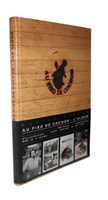Cipaille a postmodern way
Six servings.
In Number 18, we noted that the celebrated Martin Picard makes an elaborate and irresistible cipaille. We could have added that he has published his recipe in Au Pied de Cochon: The Album, and also could have described the instructions for it. That was then, however, and our discussion focused on the English origin of sea pie. What a tease. This number covers Canada, and so our version of Picard’s recipe follows without further procrastination. We have modified the recipe in several respects, not because our version is better--it is not--but rather in an effort to make it accessible enough for home cooks actually to prepare. It is both difficult and costly, for example, for most of us to obtain a hare, and beef makes a serviceable enough alternative to venison if required. None of this should be too alarming: As Picard’s co-author explains, there are as many different cipailles as there are cooks in Quebec who bake them. In any event the Notes include a recitation of Picard’s original ingredients. You will need a large oven pot.
 -6 marrowbones
-6 marrowbones
-6 chicken thighs (but see the Notes)
-6 duck drumsticks stripped of visible fat
-1 lb boneless pork shank cut into 6 pieces
-1 lb boneless venison cut into 6 pieces
-heaped ¼ teaspoon cinnamon
-¼ teaspoon ground cloves
-1 teaspoon cracked black pepper
-1 teaspoon minced savory
-salt
-1 lb peeled potatoes cut into ½ inch dice
-3 cups onions sliced into thin crescents
-2 cups onion soup (canned is fine but see the Notes)
-6 cups pork (preferred) or chicken stock
-a thawed sheet of frozen puff pastry
-a beaten egg
- Soak the bones in cold water for at least 3 hours.
Preheat the oven to 450°. - Toss the chicken, duck, pork and venison with the spices and savory, and season the mixture with the pepper and some salt.
- Toss the potatoes with the onion and season them generously with salt and pepper
- Arrange the bones in your big deep casserole and surround them with half of the onion potato mixture.
- Put all of the meats into the casserole and top them with the rest of the onion potato mixture.
- Pour the stocks into the casserole.
- Roll out the pastry if needed to cover the pie and lay it over the filling, crimping it over the perimeter of the casserole.
- Bake the pie for 30 minutes, then reduce the heat to 350, brush the pastry with the egg, cover it with foil and bake for 4 more hours, basting the crust with a little stock every ½ hour to prevent it burning.
Notes:
- Picard cuts a hare into 6 pieces in place of the chicken thighs, which would give the pie considerably more depth of flavor if you can find a hare, but the dish is rich enough without it. You could substitute beef for the venison, and if pork shank is not available, use shoulder, but it lacks the gelatin content, with its thickening and unctuous texturing properties, of the shank.
- You can of course make your own piecrust, and Picard uses ordinary pastry rather than puff. The bfia piecrust recipe appears both in the practical and in our recipes.
- Picard instructs his readers to ‘baste’ the pie but does not say what to use. We added the beaten egg at Step 8 and used stock to baste the pastry after that.
- Picard has insane recipe for onion soup, insane in the best, richest, most flavorful way, in The Album. If you would like to make his cipaille the way he does, with a dose of his own rather than store-bought or good as opposed to transcendant onion soup, buy The Album and do as he, painstakingly, does.
- If you are lucky, or perhaps skilled, the lid of your casserole will not quite coincide with the height of your marrowbones. If so, then fashion your pastry tightly around the bones with a seal to use the bones to vent the pie. If not, then lay the pastry lid atop the bones to support it and prevent sog. Either way you remain lucky.
- The marrowbones are a rustic and brilliant element and provide you with the only starting course you need. Scoop the marrow from the inside of the bone with the smallest spoon to eat on toast before devouring the pie.

